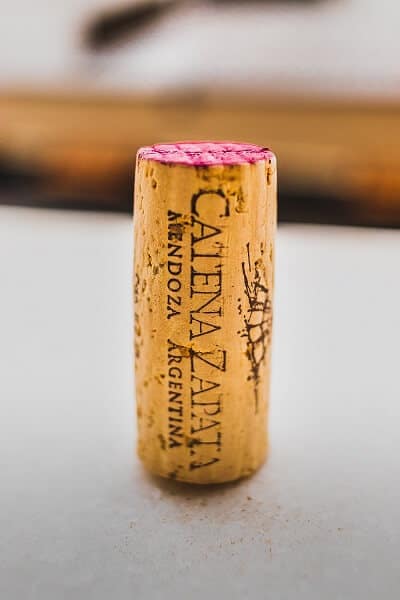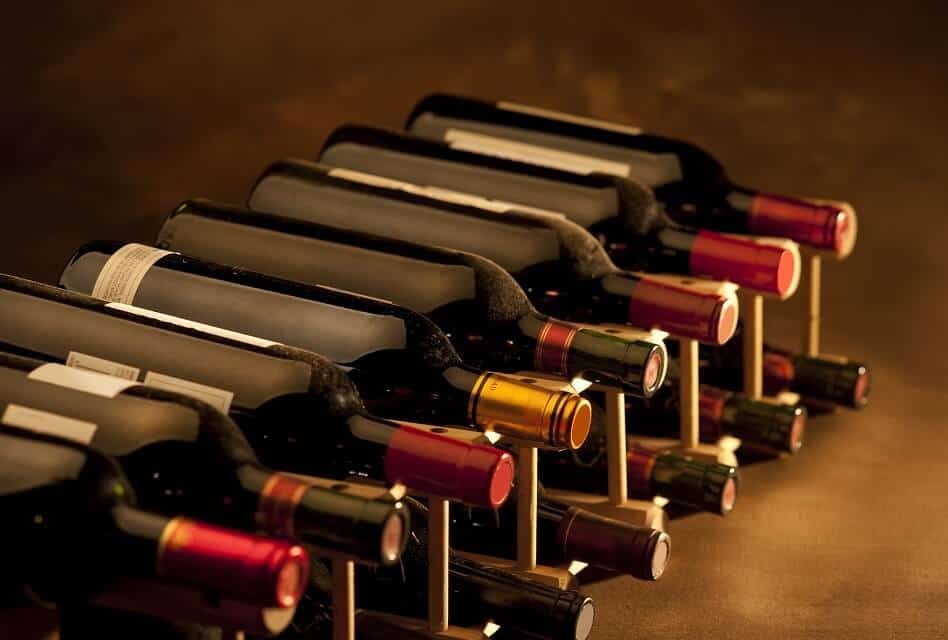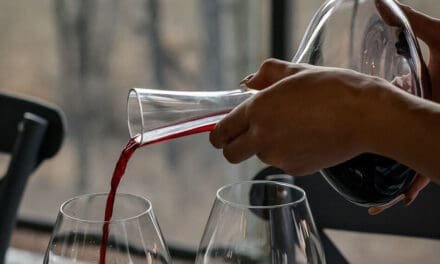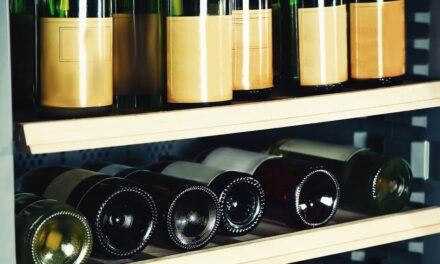Wine is stored on its side to keep the wine in contact with the cork. Otherwise, the cork might dry out, break, and ruin the wine. Besides, storing wine horizontally allows you to keep your storage in order and find bottles faster.
It is fair to say that the health of the bottle cork is directly linked to your wine’s health. Or, in other words: A damaged cork leads to ruined wine. Thus, storing wine on its side is crucial for keeping it enjoyable. But it’s not necessary for all wines. This article will discuss the details, including the types of wine you should store on their side and how to keep them safe.
WHY IS WINE BEST STORED ON ITS SIDE?
The main reason for storing wine on its side is to keep the cork moist. Cork is a natural material, but when it dries out, it becomes porous. Eventually, it crumbles, and pieces can break off. These pieces get into the wine, creating a very unpleasant drinking experience. You can filter them out by decanting (or double decanting) the wine, but it’s better to avoid it from happening in the first place.
A dried-out and damaged cork can have much more severe effects, though. If it is not airtight anymore, oxygen can get into the bottle and start chemical processes that finally result in the wine going bad. Even worse, a damaged cork can create a leak, and your wine ends spilled on the cellar floor.
There are other reasons for wine to be stored on its side: With your bottles stored horizontally, it is much easier to keep your collection in order than when they are standing next to and behind each other. Logically, it also takes less time to find a specific wine you are looking for. Thus, wine racks, as well as wine coolers, are designed for horizontal storage.
Does Wine Go Bad If Not Stored on Its Side?
If not stored on its side, the wine will not necessarily go bad. Only if the cork dries out and pieces break off does the risk of ruining it increases dramatically. But the wine quality itself is not impacted by the storing position, and wine will not go off when standing upright.
Is It Okay to Store Wine Upright?
Storing wine standing upright is not necessarily a bad thing. Only for long-term storing of cork-sealed wines, it is a no-go. But in the following cases, it is perfectly fine:
- You can keep all wines with a screw cap standing upright. As their seal cannot deteriorate when not in contact with the wine, this position will not harm a screw cap wine.
- If you plan to open a bottle soon after buying it, the risk of the cork drying out is very low. So when storing wine for only a couple of days, you can safely keep it standing upright.
- An open bottle should always stand upright. Even when resealed with a bottle stopper, the wine could leak otherwise. So do not store an already opened bottle horizontally.
WHY ARE CORKS USED TO SEAL WINE BOTTLES?
Using a fragile material such as cork for wine bottle seals might sound counterintuitive. But actually, cork has some advantages:
- Cork lets a little bit of oxygen into the bottle. This oxygen can interact with the wine and help it develop new aromas. So cork-sealed wines have the chance to get better over the years.
- Although it lets a bit of air in, the cork does not let any wine out. It is a leakproof seal.
- Cork is harvested from oak trees that don’t even need to be cut down. And after removing a cork from the bottle, it will decompose without any remains. So it is an entirely natural, renewable, and recyclable resource.
These advantages outweigh the disadvantages:
- As mentioned, cork is fragile. When it dries out, it becomes porous and might break.
- Cork is prone to taint. This condition occurs when plant phenols, chlorine, and mold interact with each other.
- Finally, cork is relatively expensive because the production process depends on the manual labor of experienced workers.

Wine Bottle Cork
SHOULD SCREW TOP WINE BE STORED ON ITS SIDE?
A wine bottle sealed with a screw cap does not need to be stored on its side. Unlike a cork, screw caps cannot dry out and break when not in contact with the wine. However, storing it horizontally will not harm a screw cap bottle either. So whether you keep it standing upright or lying on its site is up to you.
DOES RED WINE NEED TO BE STORED ON ITS SIDE?
Bottles of red wine should be stored on their side if they are sealed with a cork. That is true for the vast majority of red wines. As you cannot hurt screw cap red wines by storing them horizontally, it makes sense to keep all reds on their side to be sure.
DOES WHITE WINE NEED TO BE STORED ON ITS SIDE?
You should store white wine on its side if it is sealed with a cork. That is true for many bolder wines, particularly those aged in oak. These wines should stay in contact with their corks, so they do not dry out and break.
Young, light wines are typically made for early consumption and not for extensive storage. They are sealed with a screw cap, and thus, you can keep them either lying on the side or standing in an upright position.
DOES SPARKLING WINE NEED TO BE STORED ON ITS SIDE?
Sparkling wine bottles sealed with a cork should be stored on their sides. Like still table wines, they must be in touch with the corks, so they do not dry out and crumble. Both Champagne and Prosecco should be stored on their side, and the same goes for most other sparklers.
Even when sealed with a screw cap, sparkling wine can be stored on its side. Keeping it in a horizontal position will not harm the wine as long as it is stable, so it cannot move around. The same is true for keeping a screw cap bottle standing upright.
SHOULD PORT WINE BE STORED ON ITS SIDE?
A sealed bottle of Port wine should be stored on its side. Especially Vintage Port wines have excellent aging potential and will get better over decades. To keep them safe during that time, they should always lay on their side. Non-vintage Port has only little potential to improve over time. Nevertheless, its cork should also stay moist. So keep it in a horizontal position, too.
Once open, you cannot store Port wine bottles on their sides anymore. They are not leakproof anymore. Thus, you need to keep them standing upright.
HOW TO STORE YOUR WINES CORRECTLY
Besides being stored on its side, wine has some other requirements. If you want to keep it safe, you should take additional measures. Be aware that these recommendations focus on long-term storage. If you tend to buy wines just days before consuming them, you do not need to worry too much.
Provide the Right Storing Conditions
To maximize your wines’ shelflife and keep them enjoyable for years, follow these best practices for storing wine:
- Keep the storing temperature low and constant. Rapidly changing temperatures can seriously harm your wine.
- The right level of humidity is vital. Aim for a humidity level of 50 to 80%.
- Shield the bottles from sunlight. Just like heat, light can start chemical processes that cause your wines to spoil.
- Do not keep your wine close to vibrating devices such as air conditioning or washing machines.
- Do not store chemicals near your wines. The aggressive smells of cleaning agents, wall paint, or heating can invade wine bottles via the cork and ruin their contents.

Wine Cellar with Optimal Conditions
Inspect Your Bottle Seals from Time to Time
If you store your wines over the years, you should check their corks from time to time. Although you can’t see whether they are moist on the inside or not, you can spot leaks for sure. Depending on the bottle and wine color, you might also be able to spot pieces of cork floating in the wine.
In case you see anything wrong, you should consider opening the bottle. Either transfer the wine into another container or drink it, given that it is still enjoyable.
Make Sure to Fill Up Bottles If Necessary
Wines that you keep in your cellar for decades, slowly concentrate. That goes especially for fortified wines such as Madeira or Port. Besides a change in flavor, that also means that their content will decrease. And there might not be enough wine left to keep the cork moist at some point. In this rare case, you need to take action immediately:
- If you have multiple bottles of the exact wine, use one of them to refill the others.
- If you own only one bottle, use sterile glass balls to increase the liquid level in the bottle to a point where it is back in contact with the cork.
Consider a Wine Fridge
If you do not have a room with a constant, low temperature, consider buying a wine cooler. These special fridges provide the optimal storage temperatures for wine, protect it from vibrations, smells, and sunlight, and also look pretty cool. You can find standalone wine fridges as well as in-counter models that integrate into your kitchen perfectly.
FINAL WORDS
Many wine lovers wonder why wine is stored on its side. With the details from this article, you know the reasons, and you also know how to keep your wine safe for decades. Maybe you even got encouraged to build your little wine cellar where you can store your wine on its side and wait for it to reach its full potential.






